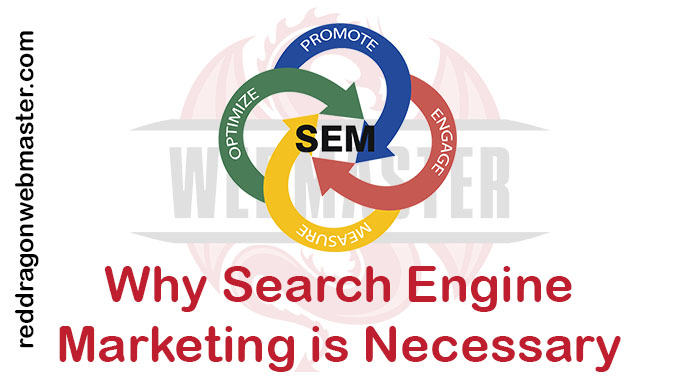

Why Search Engine Marketing is Necessary
Keywords: SEO, Marketing, Search
An important facet of SEO is creating your web site that is simple for both human users and programmed robots to navigate and read. Although search engines have become progressively subtle, they still cannot see or perceive an internet page on the same way that a human reader would. SEO helps search engines to find out what each webpage is about, and how it’s going to be helpful for its users.
A Common Argument against SEO
We frequently hear statements like this:
“No good engineer would ever build a groundwork engine that needs websites to follow bound rules or principles so as to be graded or indexed. Anyone with a brain would desire a system that may crawl through any design, break down any quantity of advanced or imperfect code, and still notice some way to come back the foremost relevant results, not those that are ‘optimized’ by unauthorized search selling consultants.”
But Wait…
Imagine you announce on-line an image of your family dog. A human may describe it as “a black, medium-sized dog, enjoying fetch within the park”. However, computer programs around the world would struggle to grasp the detail of the picture at anywhere close to that level of sophistication. Moreover, how does one build a groundwork engine to perceive a photograph? Fortuitously, SEO permits webmasters to supply clues that the search engines will use to grasp content. In fact, adding correct structure to your content is important to SEO.
Understanding both the advantages and limitations of search engines permits you to properly build, format, and annotate your web page to create a website that search engines can easily digest. If not geared to SEO, a website will be invisible to search engines.
The Limits of programmed Technology
The major search engines all work on equivalent principles, as explained in Chapter one. Machine-controlled search bots crawl the web, following links and index content in huge databases. They accomplish this with incredible computer science. However, fashionable search technology isn’t all-powerful. There are varied technical limitations that cause vital issues with each inclusion and rankings. We’ve listed the most common issues below:
Problems creep and assortment
-
Online forms: Search engines are not intelligent at finishing on-line forms (such as a login), and so any content contained behind them could stay hidden.
-
Duplicate pages: Websites employing a CMS (Content Management System) usually produce duplicate versions of an equivalent page. This can be a serious drawback for search engines trying to find the original content.
-
Poor link structures: If a website’s link structure is not comprehensible to the search engines, they’ll not reach all of a website’s content; or, if it’s crawled, the minimally-exposed content could also be deemed unimportant by the engine’s index.
-
Non-text Content: Although the search engines have improved their ability to read non-HTML text, content in media formats remains difficult for search engines to break down. This includes text in Flash files, images, photos, video, audio, and plug-in content.
-
Blocked within the code: Errors during a website’s creep directives (robots.txt) could result in blocking search engines entirely.

Problems Matching Queries to Content
-
Uncommon terms: Text that is not written within the common terms that individuals use to search for what they are looking for. As an example, writing regarding “food cooling units”, whereas people actually search for “refrigerators.”
-
Language and group action subtleties: as an example, “color” vs. “colour.” If you are in doubt, check what most people are looking for and use actual matches in your content.
-
Incongruous location targeting: Targeting content in Polish although the bulk of the people who would visit your web site are from Japan.
-
Mixed discourse signals: as an example, the title of your blog post is “Mexico’s Best Coffee”, however the post itself is a few vacation resorts in a North American nation that happens to serve nice coffee. These mixed messages send confusing signals to look engines.
Make sure your content gets seen
Getting the technical details of search engine-friendly net development correct is vital. However, once the fundamentals are covered, you also need to market your content. Search engines by themselves haven’t any got formulas to determine the standard of content on the internet. Instead, search technology depends on the metrics of relevancy and importance, and they produce those metrics by following what people do: what they discover, react, comment, and link to. So you can’t simply build an ideal web site and write nice content; you must be compelled to get that content shared and talked about.
Take a glance at any search results page and you may notice the solution to the question of why search selling has a long, healthy life ahead of itself.
There are, on average, 10 positions on the search results page. The pages that fill those positions are ordered by rank. The higher your page is on the search results page, the higher your click-through rate and skill to draw in searchers. This ends up in positions one, two, and three receiving rather more traffic than results further down the page, and significantly more results than deeper pages. The actual fact that such a lot of attention goes to those few listings at the top means there’ll forever be a money incentive for programmed rankings. However, search rankings can change in time, and websites and businesses vie with each other for this attention, and for the user traffic and complete visibility it provides.
Constantly Dynamic SEO
When search selling began within the mid-1990s, in the days of manual submission, the Meta keywords tag and keyword stuffing were all regular elements of the techniques necessary to rank well.
In 2004, link bombing with anchor text, became possible, as did shopping for hordes of links from machine-controlled blog comment spam injectors. Therefore the construction of inter-linking farms of internet sites could be leveraged for traffic. In 2011, social media selling and vertical search inclusion began to be used as good strategies for conducting programmed improvement.
The search engines have refined their algorithms alongside this evolution. Using many of the techniques that worked in 2004 will hurt your SEO nowadays.
The future is unsure, however within the world of search: modification could be a constant. For this reason, search selling can still be a priority for those who want to stay competitive online. Some have claimed that SEO is dead, or that SEO amounts to spam.
As we tend to see it, there isn’t any defense aside from easy logic: websites vie for attention and placement within the search engines, and people with the data and skill to boost their website’s ranking can receive the advantages of boosted traffic and visibility.
Call Now Button


